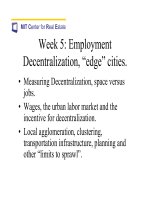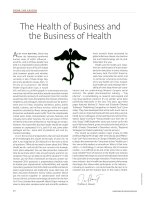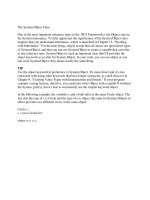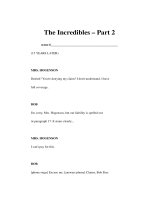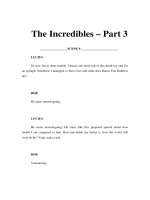Tài liệu The Morning Gap, Low Risk Opportunity for the Astute Market Speculator ppt
Bạn đang xem bản rút gọn của tài liệu. Xem và tải ngay bản đầy đủ của tài liệu tại đây (170.84 KB, 7 trang )
The Morning Gap, Low Risk Opportunity for the Astute Market Speculator
Whether I am trading or instructing a stock
, futures, or options class at Online Trading
Academy, our lowest risk and highest reward trade each day is typically the opening gap
entry. As soon as I suggest the trade to the class, someone always says: "I was told we are
not supposed to trade the open because it is not for the novice trader". That is not exactly
what we say at Online Trading Academy. What we say is that the open is not for the
novice trader. It is, however, a fantastic opportunity for the astute trader who knows how
to identify a novice trader. Most of the time, our entry is within seconds to minutes of the
opening bell. There is a reason for this…
Why do prices gap up? They gap up because there are more buy orders at the open than
there is available supply at the prior day's closing price. They gap down because there are
more sell orders at the open than willing demand at the prior day's close. Therefore,
market prices are almost always at price levels where there is a supply and demand
imbalance (opportunity) at the open. Never forget, the successful market speculator
simply finds markets where price is at levels where supply and demand are out of balance
and trades them back to price levels where supply and demand is in balance. I started in
this business on the floor of the Chicago Mercantile Exchange, handling institution and
retail order flow. Watching that order flow made it easy to see where prices were going to
turn. For example, if we had 10 buyers and 5 sellers at a price level, as soon as the 5th
seller sold, price had to rise. Having the orders in your hand makes this easy to see.
Knowing exactly what this picture looks like on a price chart makes it even easier.
This week in the markets represented obvious opportunities related to gaps and order
flow. We took advantage of them in class here in Chicago each day. We will do the same
thing in Boston next week as two things never change. First, order flow works the same
way it did 100 years ago and never changes. Second, novice traders are always present
and are only growing in numbers. Here is how it all works…
Below we have a chart of the S&P as seen through the SPY, the ETF for the S&P. "A"
represents a resistance (supply) level. We know this because price could not stay at that
level, it had to fall because there are more willing sellers than buyers at that level. "B" is
a day this week where price gapped right into that resistance (supply) level at the open.
Here, the novice trader buys and the astute trader sells to that buyer. Remember, a supply
level is a price level where there are more sellers than buyers. The last thing you want to
do is buy at that price level and that is exactly what the novice trader did that morning on
the open. In class here, we sold to that buyer and profited on the decline in price. We
know this is a novice buyer because only a consistent losing trader would buy a gap up,
after a rally in price, and into an objective supply level. The very next day at the open
"E", price gapped down into an objective demand level "D". Only a novice trader would
sell a gap down, after a decline in price, and into an objective demand (support) level,
"D". We simply bought from that novice seller and profited nicely on the trades. The very
next day at the open "C", price gapped up right into an objective supply level, "A" and
"B". That short entry at "C" was very low risk and high reward but you had to be trading
at or near the open to get that low risk short entry which was true for all the gap entries
for the week.
The key is to not look at candles on your screen as red and green pictures and patterns.
You must understand what is happening behind the scenes. Whether you're trading
stocks, futures, options, or forex, the logic and rules never change.
Again, the market imbalances are greatest at or near the open of trading in all markets. By
the end of the first hour of trading each day, a large amount of novice trading capital is
simply transferred into the accounts of the astute trader. If you can't see the novice trader
in markets, you likely are the novice trader.
A few weeks ago, I wrote a piece on morning gaps and how to trade them. Last week I
happened to be in LA instructing a stock class and on the 19th, a morning opening gap in
the US stock markets offered us a very low risk and high reward opportunity. Our
morning prep work basically consists of finding stocks that are opening at price levels
where supply and demand are out of balance in a large way and then simply trading them
back to balance. Once the traders understand the whole supply (resistance)/demand
(support) concept and the rules, we use two sources to find these opportunities which
typically present themselves right at the open of trading or shortly thereafter. One of our
sources offers us the morning broker upgrades and downgrades. An upgrade that jumped
out at us was Citigroup who was upgrading shares of Imclone (IMCL) with a "Buy"
recommendation. While we are trading real money in class, you might think we would
want to listen to this upgrade and do exactly what it is suggesting to do as Citigroup is
one of the largest banks in the world and we are just 20 people in a trading class in LA.
Well, it really depends on your point of view. Citigroup likely had good fundamental
reasons to upgrade the stock and looking at the chart below, MANY people listened with
both ears and bought IMCL on the open which is what caused that gap up in price. If
your point of view is that of a smart buyer and seller of anything who has an
understanding of the laws of supply and demand, not only were you not buying like
everyone else was, you were selling to that huge group of buyers (at least we were).
Notice the price action on 3/7. There was a dramatic price decline from the $45-$46 price
level. This can only happen because there is much more supply at that level than willing
demand. When this happens, price must decline. The dramatic rate of decline suggests a
strong supply and demand imbalance at that level. Now, notice what happens the
morning of the upgrade on 3/19. Citigroup upgrades the stock and price opens right into
that supply level. While the rest of the world is buying in a strong way, we had our plan
in place well before the open that told us to sell to anyone who wanted to buy at that
level. Why? Because we knew that if we sold to the buyers at that price level on the gap
up, we would be selling to novice buyers who likely are consistent losing market
speculators. How do we know this? Only a novice would buy AFTER an advance in price
and INTO a price level where supply exceeds demand. Our job is to find this novice
trader and simply take the other side of his or her trade.
When you enter markets at price levels where supply and demand are out of balance in a
big way, especially at or near the open of trading, moves in the market are typically very
fast. There were many other stocks this day that did the exact same thing and those who
did the 15 minutes of morning prep work that we do each day were rewarded with low
risk/high reward gains.
This trade and the thoughts and rules that went with it are not meant to impress you. I
mean to impress upon you the importance of looking at markets for what they really are
which is simply an ongoing supply and demand equation. Opportunity exists when this
simple and straightforward relationship is out of balance. Everything else in and around
markets is just "noise" that is meant to invite you into markets at the wrong time and in
the wrong direction. As an educator, I say that is unfortunate. As a trader, I love it - the
more noise the better!
For those interested in learning and applying this information in the powerful futures
markets, I will be instructing at Online Trading Academy Irvine, April 14-18. So you
know, Online Trading Academy instructors are not compensated based on the number of
people attending the courses so this is not a sales pitch. I mention my schedule in the
letters occasionally because I get emails each day with questions regarding schedules.
It's been a busy week of transition here at Online Trading Academy. I am now the XLT
(Extended Learning Track) instructor for Futures and Forex. Instead of only interacting
with students in classes once in a while, we are now able to interact during the high
volume market hours four days a week in an ongoing learning/trading experience. This
new venture will also serve as a good idea factory for my weekly letter as I plan on
highlighting important points we cover in the XLT program for you here each week.
I have written articles in the past entitled: "The Morning Gap, Part 1 and Part 2 ". Last
week's morning gaps in the equity markets provided very low risk, high reward, and high
probability opportunity but only if you understand the difference between quality support
(demand) and resistance (supply) and non-quality support and resistance. Understand that
the words support and resistance have different meanings for many people. For some,
Fibonacci levels are support and resistance. For others, moving averages are what they
count on as support and resistance. And others, pivot lows and highs or clusters of
candles on a chart are what they look for. Let's take a deeper look into this topic and
combine it with the opportunities that opening gaps provide.

